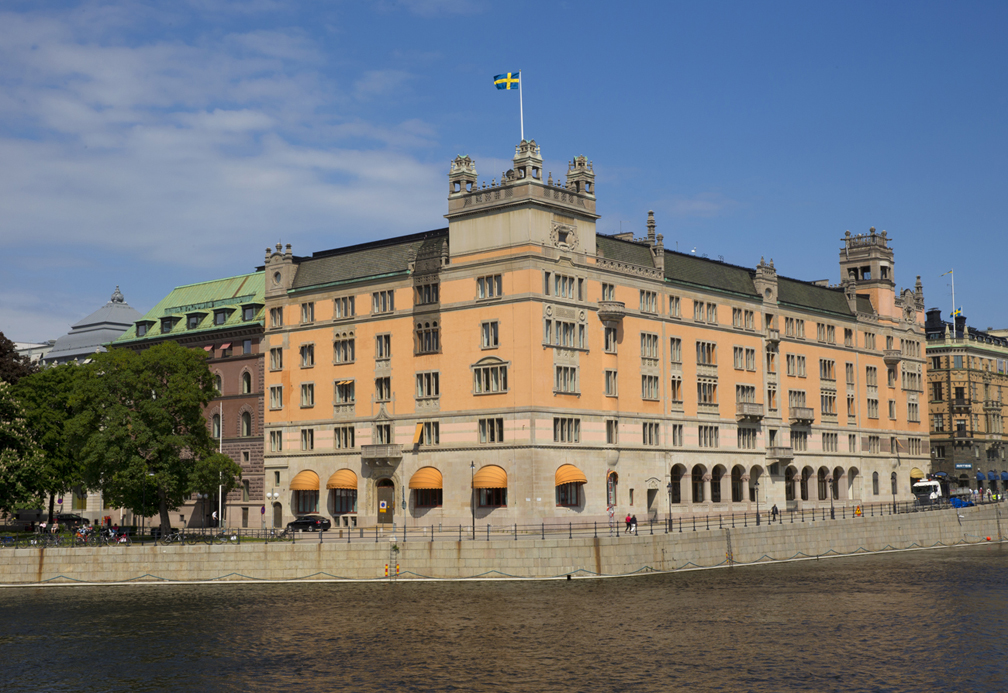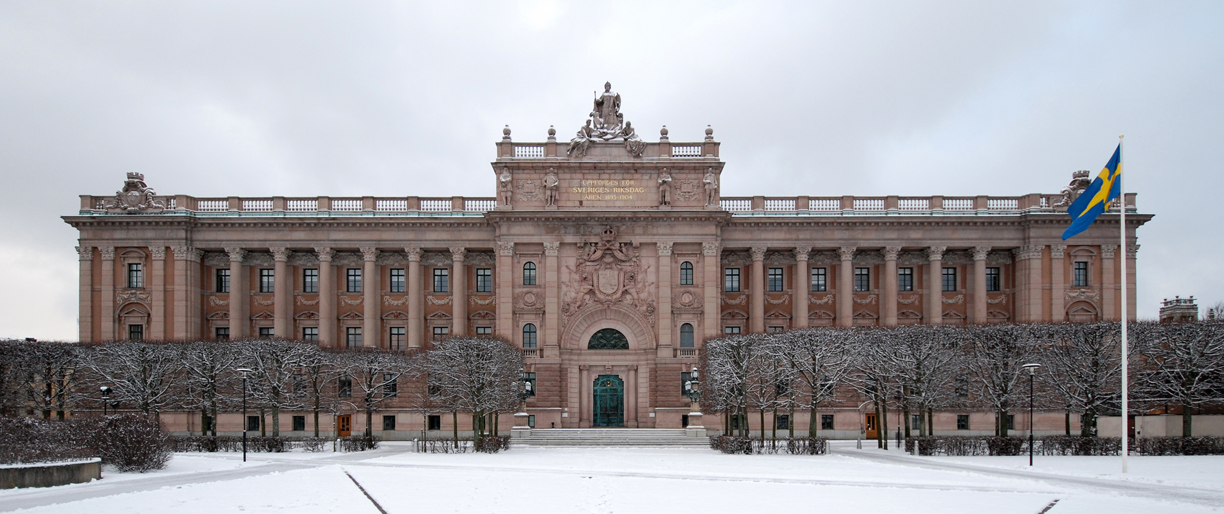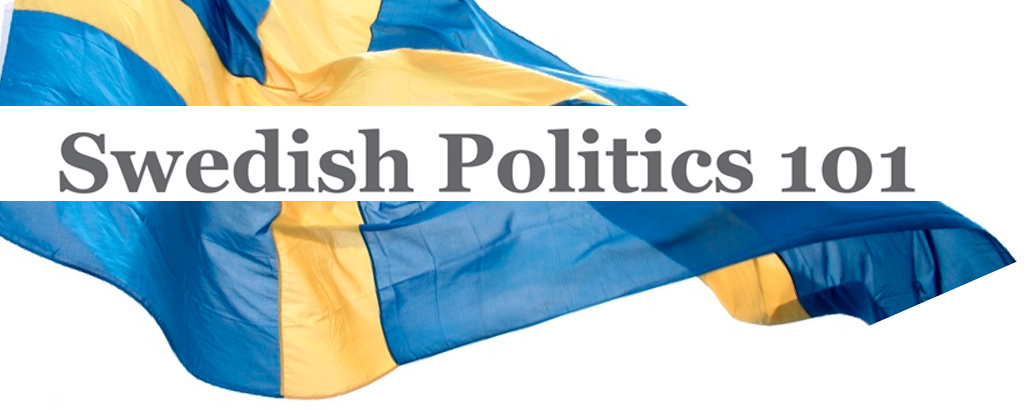Swedish Political Parties 101
Politics in Sweden seem more confusing than ever. After the general election of 2014 was followed by some of the most confusing political conflicts in recent history, keeping track of who is doing what has become very difficult, even for Swedes-in-the-know.
-
 The Prime Minister’s Office (Swedish: Statsrådsberedningen) and the Government Offices (Swedish: Regeringskansliet) are in a building called Rosenbad, designed by the architect Ferdinand Boberg, and completed in 1902. It is located close to the Sager House, the official residence of the Prime Minister. The Riksdag building and the Royal Palace are located just across the waters of Stockholms ström. Photo: Martina Huber/Regeringskansliet
The Prime Minister’s Office (Swedish: Statsrådsberedningen) and the Government Offices (Swedish: Regeringskansliet) are in a building called Rosenbad, designed by the architect Ferdinand Boberg, and completed in 1902. It is located close to the Sager House, the official residence of the Prime Minister. The Riksdag building and the Royal Palace are located just across the waters of Stockholms ström. Photo: Martina Huber/Regeringskansliet -
-
We have received more than one plea for help, requests to explain — in English — the basics of Swedish politics. Here we clarify the essence of the parliamentary democracy, currently made up of eight political parties representing the voting public, that has long been one of the world’s most stable party systems in the world.
-
 Riksdagshuset, the House of Parliament in Stockholm is the seat of Riksdagen, the Swedish Parliament. Designed by Aron Johansson and constructed between 1897 and 1905 it is located on nearly half of Helgeandsholmen (island), in the Gamla stan (old town) district of Stockholm. View above from the Norrbro bridge (Crossing over Stockholms Ström) By Larske via Wikimedia Commons
Riksdagshuset, the House of Parliament in Stockholm is the seat of Riksdagen, the Swedish Parliament. Designed by Aron Johansson and constructed between 1897 and 1905 it is located on nearly half of Helgeandsholmen (island), in the Gamla stan (old town) district of Stockholm. View above from the Norrbro bridge (Crossing over Stockholms Ström) By Larske via Wikimedia Commons -
-
The very first sentence of Sweden’s Constitution says all public power comes from the people. The people are represented in the parliamentary democratic monarchy by the Riksdagen, which has 349 members elected to serve terms of four years.
-

-
Legislative power is vested in both the government and parliament, elected within a multi-party system. (The Judiciary is independent, appointed by the government and employed until retirement.) The executive power of the government (Regeringen) is led by the prime minister and other ministers who govern the state and is answerable to the parliament, Riksdagen. The Prime Minister is the senior minister of government, while the Head of State is the king — currently Carl XVI Gustaf of Sweden (since 1973) — who has no authority in the governing of the state. (January 1, 1980 established absolute primogeniture in which the heir apparent isn’t just a royal’s firstborn son, but the firstborn child. Sweden’s heir apparent is Crown Princess Victoria, the eldest child, a daughter, of the King and his wife, Queen Silvia.)
-
Political parties
Sweden has a history of parliamentary democracy, and is currently represented in the Riksdag by eight political parties. Every party must hold a minimum of 4 percent of the people’s votes to have a seat in parliament. Today in Sweden around 7 million people are at least 18 years old and entitled to vote, influencing which political party will represent them in the Riksdag. The parties represented in the unicameral legislature and the number of seats they have (determined proportionately by the number of votes each party receives) are: -
• The Social Democrats (Socialdemokratiska Arbetar Partiet), 113 seats
• The Moderate Party (Moderata Samlingspartiet), 84 seats
• The Sweden Democrats (Sverigedemokraterna), 49 seats
• The Green Party (Miljöpartiet de gröna), 25 seats
• The Centre Party (Centern), 22 seats
• The Left Party (Vänsterpartiet), 21 seats
• The Liberal Party (Folkpartiet liberalerna), 19 seats
• The Christian Democrats (Kristdemokratiska Samlingspartiet), 16 seats -
Take a look at the leadership of each Swedish political party: Leaders of the Swedish political parties
-
Only parties that gain at least 4 percent of the vote will receive seats in parliament. One other party came close to the 4 percent rule, the Feminist Initiative, FI, founded in 2005 with the former leader of the Left Party as one of its main spokespersons. Working for women's equal rights and known for sometimes provocative and controversial actions, the party reached 3.1 percent of the vote in 2014.
-
The Social Democrats, S: The Social Democratic Workers' Party of Sweden is Sweden's oldest existing political party, founded in 1889 and representing the majority of a then unorganized labor with universal voting rights on the agenda (less than 10 percent of the adult population had the right to vote at the time). By 1976 and after close to 50 years in power, the Social Democrats had implemented the “people's home” policy (Folkhemmet), still a focus today, creating one of the world's most comprehensive systems of welfare which still gets considerable support from organized labor in Sweden.
-
The Liberal Party, FP: Founded in 1902 as a traditional European liberal party, FP advocates a market-oriented economy and social welfare system.
-
The Moderate Party, M: Founded in 1904 as the Conservative Party, and in 1969 re-named Moderata Samlingspartiet or Moderaterna, M promotes a market economy, lower taxes and a smaller role for the government in the economy. Since the 1980s when Sweden's economy suffered, the Moderates have gained strength favoring tax reform and trimming the welfare state.
-
The Centre Party, C: Founded in 1910 as the Agrarian Party, the Centre Party acquired its present name in 1958. The party represented rural interests and has tried to refashion itself as an "alternative" centrist party favoring environmental issues and maintaining close ties with rural Sweden, with a socially liberal profile focusing on environmental, social and progressive development and decentralization.
-
The Left Party, V: Established in 1917 as the Swedish Left Social Democratic Party following a split among the Social Democrats, for years V was known as the Swedish Communist Party; their policy is still focused around three main pillars: socialism, feminism and environment. It also advocates positions that champion gender equality.
-
The Christian Democrats, KD: Established in 1964 as the Christian Democratic Unity, KD changed its name in 1996. It is considered a traditional Christian-democratic party with a platform that promotes family values.
-
The Green Party, MP: In 1981 MP was founded from an anti-nuclear power movement and entered the legislature for the first time in 1988. The party emphasizes "green politics" and opposes Sweden's membership to the EU.
-
The Sweden Democrats, SD: The nationalist party was founded in 1988, emphasizing anti-immigration politics. In the 2010 general elections, SD won 5.7 percent of the votes, gaining representation for the first time in the Swedish parliament.
-
The Swedish party system has for a long time been one of the most stable party systems in the world; the Social Democrats, however, did for almost half a century dominate Swedish politics. Their dominance has weakened somewhat but they are still the single largest party.
-
Each party is normally headed by an executive committee, and their work is largely influenced by whether the party is in opposition to or in government with a majority in the Riksdag. The work of a party in government involves taking part in the formulation of government policy and trying to obtain support for it in the Riksdag — this latter task is particularly critical for minority governments. The main task for a party in opposition is to put forward political alternatives to government policy and to try to gain a majority for them.
-
The parties that lean right and tend to form coalitions are the Moderates, Liberals, the Center Party and Christian Democrats (39.4 percent of the 2014 vote), while those that often lean left together are the Social Democrats, the Left Party and the Greens (43.6 percent of the 2104 vote).
The 2014 general elections
As the leader of the Social Democrats, Stefan Löfven became prime minister, although his coalition of Social Democrats and Greens could not gain an absolute majority. S garnered 31 percent of the votes, and with the Green Party’s 6.9 percent, the left-of-centre coalition achieved 37.9 percent of the vote. Since Sweden has a system of negative parliamentarism — meaning a government can stay in power as long as it doesn’t have a majority against it — the Social Democrats and the Greens could still form a government by themselves, supported by the additional 5.7 percent of the vote for the Left Party, allowing them 43.6 percent of the vote. The centre-right Alliance, which includes the Christian Democrats and the Moderates, Liberal and Centre parties, collected 39.4 percent of the votes.
After the agreement between the two blocks of Dec. 27, 2014 it no longer takes a majority in parliament to pass a budget or secure the seat for a minority prime minister. The agreement between S, MP, M, C, FP and KD guarantees the indirect support of the non-governing parties, which will abstain from voting if the minority government is at risk of falling. The agreement is valid until 2022. -
-
